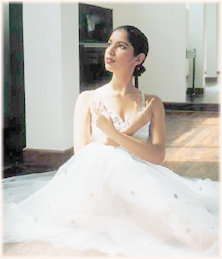
12th December 1999
Front Page|
News/Comment|
Editorial/Opinion| Plus|
Business|
Sports| Sports Plus|

![]()









Magical world of dreams
By Senaka Abeyratna
Once in two years the Deanna School of Dancing undertakes a major production
involving elaborate sets, costumes and choreography. Previous ballets presented
by the school include Carmen, Aladdin,  Peter
and the Wolf, and Beauty and the Beast.
Peter
and the Wolf, and Beauty and the Beast.
Founder of the School, Deanna Jayasuriya, a fully qualified and registered teacher of the Royal Academy of Dancing, U.K, is a qualified flamenco and jazz dancer as well. Deanna, who has a keen ear for music, started dancing at the age of three at the Yvonne Bradley School of Dance, Colombo. After schooling at St. Bridget's, she went to England to pursue a career in classical ballet. While in London, she learnt ballet under Ruth French, a former major examiner of the RAD, and qualified as a ballet teacher at the same institution.
Deanna taught ballet in the UK for ten years before returning to Sri
Lanka to set up her own school, in May 1980. The classes, which range from
pre-primary to elementary level, are designed to give students a solid
foundation in classical ballet. Deanna is proud of the fact that her school
has maintained a 100% pass rate at the exams (which are conducted by RAD
teachers) and that some of her past pupils have qualified overseas and
are holding teaching posts abroad. Deanna, who goes to  London
once a year to take a refresher course, opened her new studio at Longdon
Place in October this year.
London
once a year to take a refresher course, opened her new studio at Longdon
Place in October this year.
Her students will be performing the full-length ballet of The Nutcracker (known in the early days as Casse-Noisette) at the Bishop's College Auditorium, from December 16 to 19. The ballet was first performed at the Maryinsky Theatre, St. Petersburg, on December 17, 1892. Marius Petipa wrote the book (based on a tale by E.T.A. Hoffmann) and Pyotr Ilyich Tchaikovsky, the music. Although the choreography is generally attributed to Petipa, it was Lev Ivanov who created most of it.
The main theme of The Nutcracker is Christmas and the majestic music provides abundant opportunities for adaptation and innovation. Not surprisingly, therefore, numerous choreographers have staged their own versions of the ballet, including George Balanchine, Rudolph Nureyev, Yury Grigorovich, and Roland Petit. Nonetheless, the essence of the ballet has remained intact.
The Nutcracker ACT ONE The head of state and his wife (Mr. and Mrs.
Stahlbaum) are giving their annual Christmas party, and the children, including
their daughter and son (Clara and Fritz), are prancing round a beautiful
Christmas tree, laden with gifts. The Councillor (Drosselmeyer) - a flamboyant
character who also happens to be Clara's godfather - enters and mingles
with the crowd. He later reappears as the magician and entertains the crowd
by winding up toys and making them dance. He gives Clara a toy nutcracker
and she proceeds to dance gleefully, clutching it to her  breast.
But Fritz snatches it from her hands and severs its head. The magician,
however, repairs the nutcracker and gives it back to Clara, who places
her beloved toy beside the Christmas tree. After the party is over, Clara
goes to sleep and dreams that she is back in the hall where the party was
held. The Christmas tree grows to an incredible size and she finds herself
surrounded by an army of mice, led by the mouse king. Then the toy soldiers
appear, led by the nutcracker, and try to defend Clara. The soldiers finally
win the battle, the mouse king is slain, and the magician transforms the
nutcracker into a handsome Prince, who dances with Clara and takes her
on a magical journey. The celebrated snow scene follows with beautiful
swirling snowflakes.
breast.
But Fritz snatches it from her hands and severs its head. The magician,
however, repairs the nutcracker and gives it back to Clara, who places
her beloved toy beside the Christmas tree. After the party is over, Clara
goes to sleep and dreams that she is back in the hall where the party was
held. The Christmas tree grows to an incredible size and she finds herself
surrounded by an army of mice, led by the mouse king. Then the toy soldiers
appear, led by the nutcracker, and try to defend Clara. The soldiers finally
win the battle, the mouse king is slain, and the magician transforms the
nutcracker into a handsome Prince, who dances with Clara and takes her
on a magical journey. The celebrated snow scene follows with beautiful
swirling snowflakes.
ACT TWO Clara and the Nutracker Prince continue on their journey and meet the Sugar Plum Fairy, who instructs her subjects to perform a series of ethnic dances, including a Chocolate dance (Spanish), a Coffee dance (Arabian), a Tea dance (Chinese), a Trepak (Russian dance), and a dance of the flutes. The divertissement is followed by the Waltz of the Flowers, and then comes an exquisite pas de deux, performed by the Sugar Plum Fairy and her prince. Finally, there is a grand ensemble in which Clara also dances. The magician appears and the dream ends. A special feature of Deanna's production is the Spanish dance, which will be performed by three professional Spanish dancers who are here at the invitation of the school. They will perform in the first half of the programme as well. Roland Petit described the Nutracker ballet as "a love story, an adolescent's awakening to love. More than a fairy tale, it is a tale about life, about the awakening to life". Perhaps this is why the ballet has withstood the test of time and become an endearing classic.
Return to Mirror MagazineContents
![]()
Front Page| News/Comment| Editorial/Opinion| Plus| Business| Sports| Sports Plus| Mirror Magazine
Please send your comments and suggestions on this web site to


